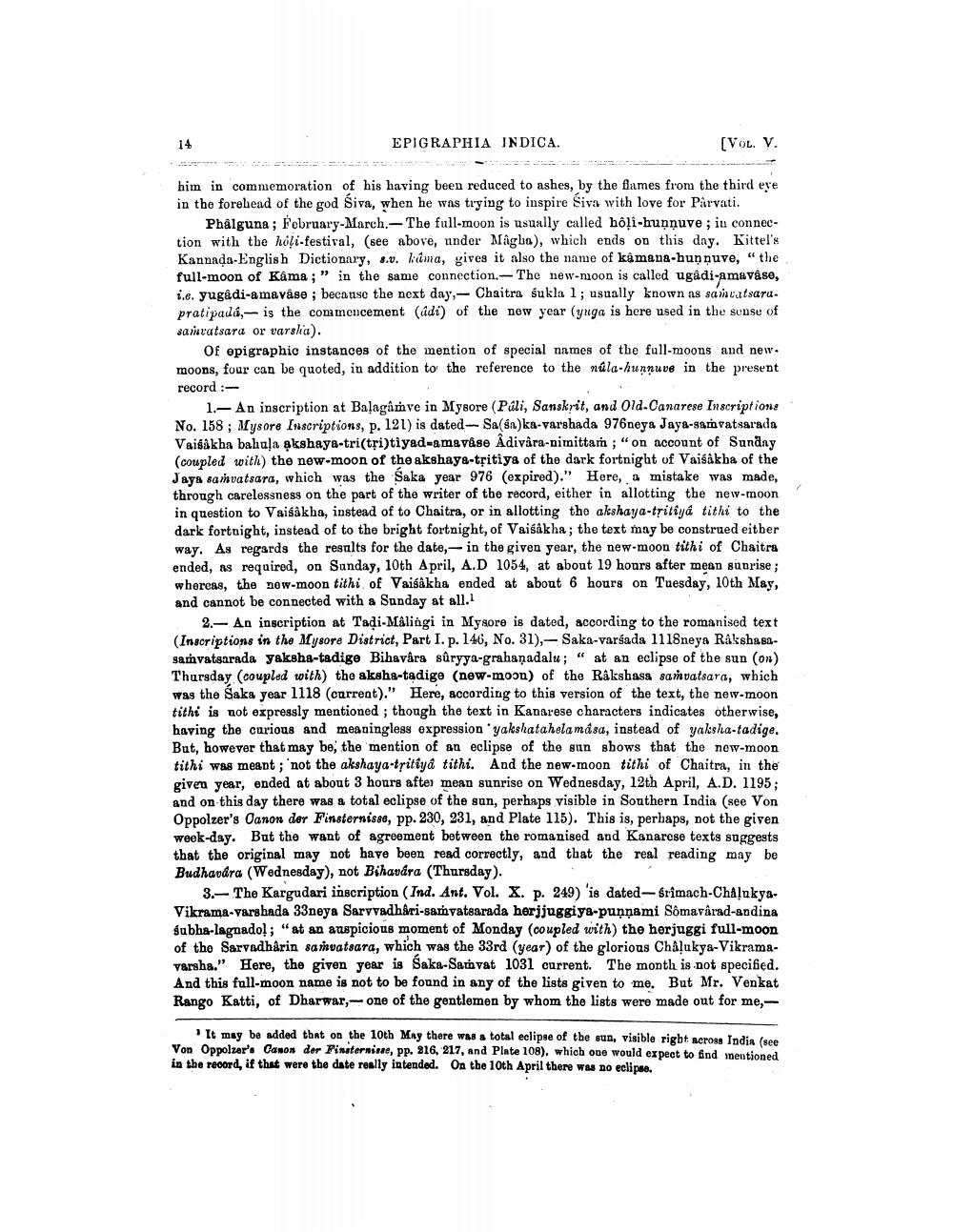________________
14
EPIGRAPHIA INDICA.
[Vol. V.
him in commemoration of his having been reduced to ashes, by the flames from the third eye in the forehead of the god Siva, when he was trying to inspire Siva with love for Parvati.
Phâlguna; February March. The full-moon is usually called hôļi-huņņuve; in connection with the holi-festival, (see above, under Mägba), which ends on this day. Kittels Kannada-English Dictionary, 8.v. kama, yives it also the name of ke mana-hunnuve, “the full-moon of Kama; " in the same connection. The new-moon is called ugadi-amavåse, i.e. yugå di-amavåse ; because the next day,- Chaitra sukla 1; usually known as samoatsaru. prati padá, - is the commencement (adi) of the new year (ynga is here used in the sense of samvatsara or varsha).
Of epigraphic instances of the mention of special names of the full-moons and new. moons, four can be quoted, in addition to the reference to the nula-hunnuve in the present record :
1.- An inscription at Balagâmve in Mysore (Pali, Sanskrit, and Old.Canarese Inscriptions No. 158; Mysore Inscriptions, p. 121) is dated-Sa(sa)ka-varshada 976neya Jaya-samvatsarada Vaigikha bahala akshaya-tri(tri)tiyad-amavåse Adivåra-nimittam ; "on account of Sunday (coupled with the now-moon of the akshaya-tsitiya of the dark fortnight of Vaisakha of the Jaya samvatsara, which was the Saka year 976 (expired)." Here, a mistake was made, through carelessness on the part of the writer of the record, either in allotting the new-moon in question to Vaisakha, instead of to Chaitra, or in allotting the akshaya-tritiya tithi to the dark fortnight, instead of to the bright fortnight, of Vaisakha; the text may be construed either way. As regards the results for the date,- in the given year, the new-moon tithi of Chaitra ended, as required, on Sunday, 10th April, A.D 1054, at about 19 hours after mean sunrise ; whereas, the now-moon tithi of Vaisakha ended at about 6 hours on Tuesday, 10th May, and cannot be connected with a Sunday at all.
2.- An inscription at Tadi-Mâlingi in Mysore is dated, according to the romanised text (Inscriptions in the Mysore District, Part I. p. 146, No. 31),- Saka-varsada 1118neya Rakshabasamvatsarada yaksha-tadige Bihavårs sûryya-grahaņadalu; " at an eclipse of the sun (on) Thursday (coupled with the aksha-tadige (new-moon) of the Rakshasa samvatsara, which was the Saka year 1118 (current)." Here, according to this version of the text, the new-moon tithi is not expressly mentioned ; though the text in Kanarese characters indicates otherwise, having the curious and meaningless expression yakshatahela mäsa, instead of yaksha-tadige. But, however that may be, the mention of an eclipse of the sun shows that the new-moon tithi was meant ; 'not the akshaya-tritiya tithi. And the new-moon tithi of Chaitra, in the given year, ended at about 3 hours after mean sunrise on Wednesday, 12th April, A.D. 1195; and on this day there was a total eclipse of the son, perhaps visible in Southern India (see Von Oppolzer's Oanon der Finsternisse, pp. 230, 231, and Plate 115). This is, perhaps, not the given week-day. But the want of agreement between the romanised and Kanarese texts suggests that the original may not have been read correctly, and that the real reading may be Budhavára (Wednesday), not Bihaudra (Thursday).
3.- The Kargudari inscription (Ind. Ant. Vol. X. p. 249) 'is dated - Srimach-ChâļukyaVikrama-varghada 33neya Sarvvadhåri-samvatsarada herjjuggiya-puņņami Somavärad-andina subha-lagnado!; "at an auspicious moment of Monday (coupled with the herjuggi full-moon of the Sarvadhárin samvatsara, which was the 33rd (year) of the glorious Chalukya-VikramaVarsha." Here, the given year is Saka-Samvat 1031 current. The month is not specified. And this fall-moon name is not to be found in any of the lists given to me. But Mr. Venkat Rango Katti, of Dharwar, - one of the gentlemen by whom the lists were made out for me,
It may be added that on the 10th May there was a total eclipse of the sun, visible right across India (see Von Oppolzar's Canon der Finsternine, pp. 216, 217, and Plate 108), which one would expect to find mentioned in the record, if that were the date really intended. On the 10th April there was no eclipse.




